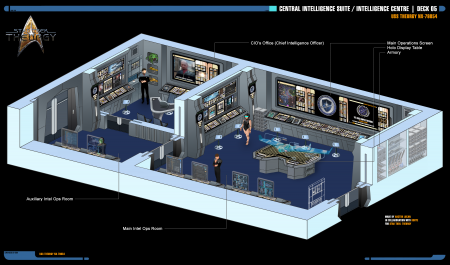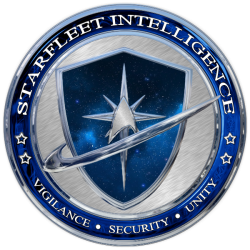Starfleet Intelligence: Difference between revisions
From Star Trek: Theurgy Wiki
Auctor Lucan (talk | contribs) No edit summary |
Auctor Lucan (talk | contribs) No edit summary |
||
| (14 intermediate revisions by the same user not shown) | |||
| Line 1: | Line 1: | ||
[[File:STARFLEET-INTELLIGENCE.png|250px|right]] | [[File:STARFLEET-INTELLIGENCE.png|250px|right]][[Starfleet Intelligence]] was a branch of [[Starfleet]] responsible for gathering and analyzing information concerning neighboring powers in the galaxy. The duties included scouting of potentially dangerous space, recognisance of enemy locations of interest, and classification of enemy ships. This, just to name a few tasks. [[Starfleet Intelligence]] also maintained a small number of operatives, and countered operatives, within the governments of threats and potential threat races. It was also responsible for the analysis of potentially dangerous cultures possessing [[warp]] travel. Another branch of [[Starfleet Intelligence]] was the Department of Internal Affairs, which was charged with keeping track of [[Starfleet]] [[operations]] to ensure that no [[security]] leaks occurred. | ||
==Mission Status== | |||
This segment describes the current situation aboard the ''Theurgy''. | |||
UNDER CONSTRUCTION | |||
==Positions== | |||
As of 2381, these were the different roles in this department: | |||
{| class="wikitable " style=" background: #252525; color: white; white-space: wrap; " | |||
|- | |||
! colspan="2" style="background:#343434; color:white"| '''[[Starfleet Intelligence]] Roles''' | |||
|- | |||
|'''<font color=orange>Role''' | |||
| style="width: 400pt;"|'''<font color=orange>Description''' | |||
|- | |||
|'''Chief Intelligence Officer'''<br> | |||
| style="width: 400pt;"|Responsible for managing the Intelligence Department in its various facets, the Chief Intelligence Officer (CIO) often assisted the Senior Staff of a ship with information gathering and analysis, and also acted as a channel of information to the CO and bridge crew during combat situations. The Chief Intelligence Officer would usually liaise closely with [[Starfleet Intelligence]] and was issued orders to only disclose information that passed through selected channels on a need-to-know basis. As of March 2381, it was unknown to which extent this would occur on the ''[[USS Theurgy]]'' given the delicate nature of the mission to overthrow [[Starfleet Command]]. | |||
|- | |||
|'''Deputy Chief Intelligence Officer'''<br> | |||
| style="width: 400pt;"|The DCIO was second in command after the CIO in the ship's or starbase's Intelligence Department, and could act in their stead at any given time. Should be of Lieutenant [[rank]] or above. | |||
|- | |||
|'''Intelligence Officer'''<br> | |||
| style="width: 400pt;"|The Intelligence Officer reported to the CIO and ACIO in the ship's or starbase's Intelligence Department. As mentioned, the responsibilities which were common to most Intelligence Officers included compiling and analysing intelligence to determine the identities, intentions, capabilities and activities of hostile individuals or groups, and planning or enacting the necessary steps to disrupt or prevent such activities. An Intelligence Officer could also work specifically with recognisance or covert [[operations]]. | |||
|- | |||
|'''Senior Intelligence Analyst'''<br> | |||
| style="width: 400pt;"|The Senior Intelligence Analyst's job is to receive either raw information from sources, or to receive intelligence reports and analysis from other sources. An analyst often specializes in cryptography and algorithmic means of intelligence such as password cracking, keyword flagging, and more. | |||
|- | |||
|'''Intelligence Analyst'''<br> | |||
| style="width: 400pt;"|The Intelligence Analyst's job is to receive either raw information from sources, or to receive intelligence reports and analysis from other sources. An analyst often specializes in cryptography and algorithmic means of intelligence such as password cracking, keyword flagging, and more. | |||
|- | |||
|'''Specialists'''<br> | |||
| style="width: 400pt;"|In order to get the best intel, [[Starfleet Intelligence]] sometimes relied on non-[[Starfleet]] personnel to get what they needed. These specialists could be given provisional ranks as required, as long as their loyalty was proven and they generated the best results. One such specalist was the Encryption & Comms Specialist [[Selena Ravenholm]] on the ''Theurgy''. | |||
|} | |||
==== | ==Duties== | ||
[[File:34 - CENTRAL INTELLIGENCE AREA.png|thumbnail|450px|<small>''Image: Central Intelligence Suite, Deck 05 on the [[USS Theurgy]]''</small>]][[Starfleet Intelligence]] employed agents for their field [[operations]] who were authorised to perform undercover investigations. The head of the organization was known as the Chief of [[Starfleet Intelligence]]. Another prominent role in the organisation was the Director/Head of Covert [[Operations]], which as of the year 2381 was Rear Admiral Joseph Nerva Andersson. It was for these missions that SI maintatined a small number of unmarked civillian vessels, for the insertion and retreival of [[Federation]] operatives. An Intelligence Officer was a title given to an officer aboard a starship or space station who is responsible for intelligence matters. Intelligence Cadets usually took courses in Communications, [[Operations]] or [[Security]], but any other division could be taken as a Minor. Training included: Cryptanalysis; Communications; [[Security]] Systems; Sensors; Intelligence Analysis; Interrogation; piloting (small crafts); Psychology; Sensor Jamming; [[Starfleet]] Protocol; Survival; Small Unit Tactics; Unarmed Combat & Marksmanship (handphaser and rifle). | |||
Best achieved by being a watcher, SI used listening posts and monitoring stations. Information could be gleaned from any source including commercial traffic [[tactical]] scans or border patrol sensor readings. On occasion, if sanctioned, a clandestine crossed border operation could be launched. This was coordinated by an intelligence officer who was assigned to a sector with a small support unit. They also covered the monitoring of military technological development of friendly and unfriendly species or enemy factions. Normally intelligence operatives used an undercover or clandestine typed of operation gathering for this type of information, which would be specific to a technology that gave an unfriendly or a dangerous faction the ability to commit mass destruction or held a significant technological advantage over the [[Federation]]. The aim was to ensure that [[Starfleet]] had no surprises in the field of combat, that they were aware of the unfriendly species combat capability and ability to detect cloaked ships or the like. This was a perpetual work in progress as unfriendly species introduced upgraded or new systems. | |||
Occasionally the Head of Covert [[Operations]] might sanction a mission whereby a team of intelligence operatives were sent into hostile situations to either conduct covert [[operations]] which were detrimental to the hostile target, or overt [[operations]] in liaison with present forces to quickly neutralize a hostile environment. This, based on the casework done by operatives prior to the [[operations]] commencing. | |||
[[Category:Departments]] | [[Category:Departments]] | ||
Latest revision as of 12:42, 8 March 2022
Starfleet Intelligence was a branch of Starfleet responsible for gathering and analyzing information concerning neighboring powers in the galaxy. The duties included scouting of potentially dangerous space, recognisance of enemy locations of interest, and classification of enemy ships. This, just to name a few tasks. Starfleet Intelligence also maintained a small number of operatives, and countered operatives, within the governments of threats and potential threat races. It was also responsible for the analysis of potentially dangerous cultures possessing warp travel. Another branch of Starfleet Intelligence was the Department of Internal Affairs, which was charged with keeping track of Starfleet operations to ensure that no security leaks occurred.
Mission Status
This segment describes the current situation aboard the Theurgy.
UNDER CONSTRUCTION
Positions
As of 2381, these were the different roles in this department:
| Starfleet Intelligence Roles | |
|---|---|
| Role | Description |
| Chief Intelligence Officer |
Responsible for managing the Intelligence Department in its various facets, the Chief Intelligence Officer (CIO) often assisted the Senior Staff of a ship with information gathering and analysis, and also acted as a channel of information to the CO and bridge crew during combat situations. The Chief Intelligence Officer would usually liaise closely with Starfleet Intelligence and was issued orders to only disclose information that passed through selected channels on a need-to-know basis. As of March 2381, it was unknown to which extent this would occur on the USS Theurgy given the delicate nature of the mission to overthrow Starfleet Command. |
| Deputy Chief Intelligence Officer |
The DCIO was second in command after the CIO in the ship's or starbase's Intelligence Department, and could act in their stead at any given time. Should be of Lieutenant rank or above. |
| Intelligence Officer |
The Intelligence Officer reported to the CIO and ACIO in the ship's or starbase's Intelligence Department. As mentioned, the responsibilities which were common to most Intelligence Officers included compiling and analysing intelligence to determine the identities, intentions, capabilities and activities of hostile individuals or groups, and planning or enacting the necessary steps to disrupt or prevent such activities. An Intelligence Officer could also work specifically with recognisance or covert operations. |
| Senior Intelligence Analyst |
The Senior Intelligence Analyst's job is to receive either raw information from sources, or to receive intelligence reports and analysis from other sources. An analyst often specializes in cryptography and algorithmic means of intelligence such as password cracking, keyword flagging, and more. |
| Intelligence Analyst |
The Intelligence Analyst's job is to receive either raw information from sources, or to receive intelligence reports and analysis from other sources. An analyst often specializes in cryptography and algorithmic means of intelligence such as password cracking, keyword flagging, and more. |
| Specialists |
In order to get the best intel, Starfleet Intelligence sometimes relied on non-Starfleet personnel to get what they needed. These specialists could be given provisional ranks as required, as long as their loyalty was proven and they generated the best results. One such specalist was the Encryption & Comms Specialist Selena Ravenholm on the Theurgy. |
Duties

Starfleet Intelligence employed agents for their field operations who were authorised to perform undercover investigations. The head of the organization was known as the Chief of Starfleet Intelligence. Another prominent role in the organisation was the Director/Head of Covert Operations, which as of the year 2381 was Rear Admiral Joseph Nerva Andersson. It was for these missions that SI maintatined a small number of unmarked civillian vessels, for the insertion and retreival of Federation operatives. An Intelligence Officer was a title given to an officer aboard a starship or space station who is responsible for intelligence matters. Intelligence Cadets usually took courses in Communications, Operations or Security, but any other division could be taken as a Minor. Training included: Cryptanalysis; Communications; Security Systems; Sensors; Intelligence Analysis; Interrogation; piloting (small crafts); Psychology; Sensor Jamming; Starfleet Protocol; Survival; Small Unit Tactics; Unarmed Combat & Marksmanship (handphaser and rifle).
Best achieved by being a watcher, SI used listening posts and monitoring stations. Information could be gleaned from any source including commercial traffic tactical scans or border patrol sensor readings. On occasion, if sanctioned, a clandestine crossed border operation could be launched. This was coordinated by an intelligence officer who was assigned to a sector with a small support unit. They also covered the monitoring of military technological development of friendly and unfriendly species or enemy factions. Normally intelligence operatives used an undercover or clandestine typed of operation gathering for this type of information, which would be specific to a technology that gave an unfriendly or a dangerous faction the ability to commit mass destruction or held a significant technological advantage over the Federation. The aim was to ensure that Starfleet had no surprises in the field of combat, that they were aware of the unfriendly species combat capability and ability to detect cloaked ships or the like. This was a perpetual work in progress as unfriendly species introduced upgraded or new systems.
Occasionally the Head of Covert Operations might sanction a mission whereby a team of intelligence operatives were sent into hostile situations to either conduct covert operations which were detrimental to the hostile target, or overt operations in liaison with present forces to quickly neutralize a hostile environment. This, based on the casework done by operatives prior to the operations commencing.

